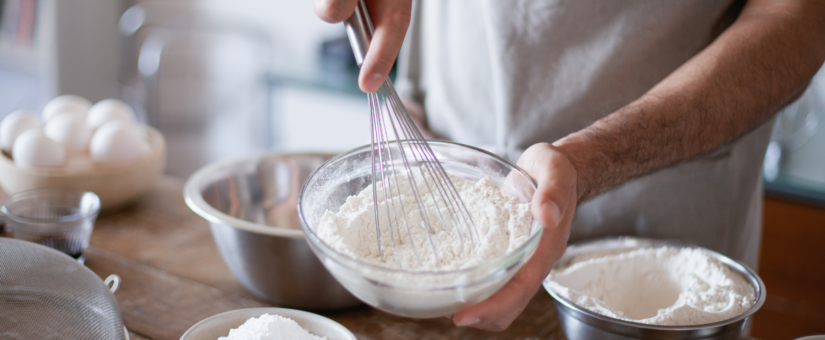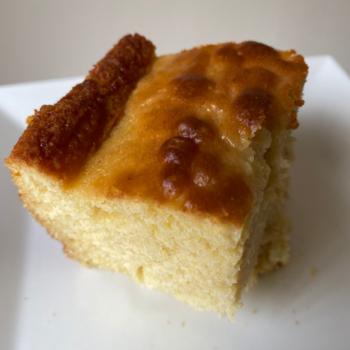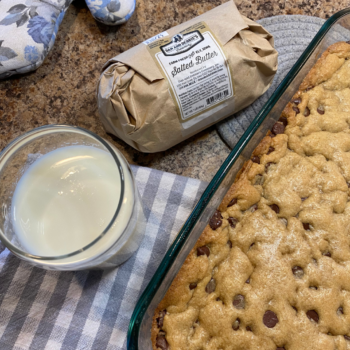
10 Baking Secrets You Need to Know
1. Have the right butter consistency.
Butter is a staple in so many great baked goods, and its consistency can have a big effect on the outcome of your creation. Usually a recipe will call for softened, chilled, or melted butter – all of which can create a different texture in your final baked good.
The majority of recipes will call for softened, or room temperature, butter. What you might not know is room temperature butter should be cool to the touch, not warm. When you press into the butter your finger should make an indent, but not sink down into the butter. To achieve this perfect room temperature butter, leave it on the counter for about an hour before you are going to begin your recipe. Recipes like these Strawberry Lemon Blondies or this amazing Cornbread call for our Salted Butter to be at room temperature- try it out for yourself!
Unlike softened butter, chilled butter is often used to create flaky pockets in recipes like biscuits, scones, or pizza and pie crusts. Use our salted butter straight out of the refrigerator or freezer so it doesn’t melt during mixing. Try this technique in this Biscuit recipe!
The other way a recipe might call your butter to be in is melted. Melted butter should be lukewarm and liquified; if it is too hot it can actually cook the eggs in your batter! We used melted butter in this Cheesy Zucchini Bread!
Have you tried baking with our farm fresh butter? Once you do, you may never go back to store bought butter again! See why fresh butter is better.
2. Read the whole recipe beforehand.
We have all been there. We start in on a recipe only to realize that you need a certain kitchen utensil, or you have to chill the dough for an hour before baking. Reading the recipe before starting will save you time, ingredients, extra trips to the store, and headaches!
3. Prep all the ingredients ahead of time.
Measuring, cutting, and prepping your ingredients before you start in on a recipe can help ensure there are minimal errors in your baking. Set all the measured ingredients out on your counter before starting, that way you can just dive right in without running around your kitchen in the middle of your process!
Don’t have all the ingredients? While you can make substitutions and some recipes will give advice on what substitutions to make, baking is chemistry. And substitutions can create different results in your baked good.
4. Use an oven thermometer.
Believe it or not, your oven could be anywhere from 10-100 degrees off! And it may not cause issues when you are cooking, but there is less forgiveness in baked goods. Get a simple oven thermometer and place it in the center of your oven. They are inexpensive, but they can help you out greatly in your baking. If you use a convection oven instead of a traditional oven, reduce the temperature by 25°F, and you may want to reduce the baking time too.
5. Keep that oven closed!
I am guilty of this, I get so excited to see my creation that I keep opening the oven door. Peeking inside the oven frequently can cause the temperature to change in the oven. I suggest using the light feature on your oven if it has one to keep an eye on your recipe. And when you need to test for doneness, do so as quickly as you can.
6. Don’t skip chilling.
Chilling cookie dough will firm it up and decrease the possibility that your freshly baked cookies will over spread. Also, cold cookie dough is a lot easier to shape. If your recipe calls for chilling, don’t skip that step! If your cookie dough is sticky, try chilling it before rolling and baking it.
7. Try storing your cookies with bread.
Have you heard of this baking trick before? To keep your leftover cookies soft longer, store then with a piece of bread. Stick that bread in your cookie jar or container and the cookies will absorb the moisture from the bread and leave your cookies soft for days!
8. Don’t over mix the ingredients.
In a lot of baking recipes you will see the phrase, “Do not over mix.” This is because once you add flour into your ingredients, mixing will encourage the gluten to develop and create a chewy texture. This is why you knead bread dough, to activate the gluten so your bread has a good chew to it, but you don’t want that in your cakes, muffins or scones! So next time you see the recipe say don’t over mix, make sure you stir the batter only until it is just combined.
9. Make your own buttermilk.
Lots of baking recipes call for buttermilk and you can make it easily at home with just two ingredients! Pour 1 Tbsp. of lemon juice or white vinegar into 1 cup of Dan & Debbie’s Whole Milk. Let your buttermilk sit for 10 minutes, then add it to your recipe. That’s it!
Want to try it for yourself? Try this buttermilk chocolate cake recipe!
10. Use quality, local ingredients.
What ingredients you use makes a big difference in every recipe! And using quality, local goods in your baking recipes will make that creation a whole lot better. Stop by our creamery and grab all the kitchen staples you need for your baking fun!
- Posted by Elizabeth Uthoff
- On September 1, 2023
- 0 Comments



0 Comments